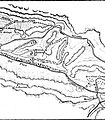Battle of Cerro Gordo facts for kids
Quick facts for kids Battle of Cerro Gordo |
|||||||
|---|---|---|---|---|---|---|---|
| Part of the Mexican–American War | |||||||
 The Battle of Cerro Gordo by Carl Nebel. |
|||||||
|
|||||||
| Belligerents | |||||||
| Commanders and leaders | |||||||
| Winfield Scott | Antonio López de Santa Anna | ||||||
| Strength | |||||||
| 8,700 - 12,000 | 9,000 - 12,000 | ||||||
| Casualties and losses | |||||||
| 63 killed 368 wounded |
1,000+ killed 3,036 captured |
||||||
The Battle of Cerro Gordo was an important fight in the Mexican–American War. It happened on April 18, 1847. During this battle, Winfield Scott's United States troops outsmarted the larger Mexican army. They managed to get around Antonio López de Santa Anna's forces. This forced the Mexican army to leave their strong defensive spot.
Contents
Background: Why the Battle Happened
After the United States army captured the port of Veracruz on March 29, 1847, General Winfield Scott began moving towards Mexico City. He started this journey on April 2. General Antonio López de Santa Anna was leading the Mexican forces in the area. He had set up strong defenses at a place called Cerro Gordo, near Xalapa.
More than 8,700 Mexican soldiers were in a narrow, fortified valley, or defile. This area was controlled by a hill called El Telegrafo. Several groups of cannons, called batteries, were also placed there. On April 12, Scott's lead group, led by David E. Twiggs, reached the Cerro Gordo Pass.
Battle: How the Fight Unfolded
On April 12, a young engineer named Lieutenant P. G. T. Beauregard figured out something important. He realized that if the U.S. army could take Atalaya Hill, they could get around the Mexican defenses. To find a way to attack the enemy from behind, engineers like Captain Robert E. Lee looked for paths. They even built new roads. These roads were made at night so the enemy wouldn't notice.
Ulysses S. Grant, who later became a famous general, wrote about how important these engineers were. He said they built roads over very steep cliffs. Soldiers had to pull cannons down and up these steep slopes by hand. This secret path helped the U.S. army win.
On April 17, Twiggs' group successfully took Atalaya Hill. They then moved up the slopes towards El Telegrafo. Santa Anna sent more soldiers to El Telegrafo to make it stronger.
At 7:00 AM on April 18, the U.S. attack began. General Twiggs ordered William S. Harney's soldiers to attack the front of El Telegrafo. At the same time, Bennett C. Riley's group attacked from the back. This combined attack quickly captured the hill. The Mexican General Ciriaco Vasquez was killed. Captain John B. Magruder then turned the captured Mexican cannons on the retreating Mexican soldiers.
At the same time, James Shields' group attacked the Mexican camp. They took control of the main road to Jalapa. Once the Mexican commanders realized they were surrounded, they gave up. By 10:00 AM, the remaining Mexican forces ran away. The Americans captured 199 officers and 2,837 other soldiers.
Aftermath: What Happened Next
General Santa Anna was surprised by the attack. He had to quickly escape without his artificial leg! U.S. forces captured it. This leg became a famous war trophy. It was even displayed in a museum by showman P. T. Barnum. Later, it was given to the state of Illinois. It was displayed in the Illinois State Military Museum.
A Mexican official visiting the museum was embarrassed to see it. So, it was removed from display. There has been talk about returning the leg to Mexico. Some cannons captured at Cerro Gordo were also brought back to the United States as war trophies.
After the battle, General Scott continued his march. He moved on to Xalapa. His division, led by William J. Worth, captured San Carlos Fortress on April 22. Scott then took over Puebla on May 15. He finally left for Mexico City on August 7.
Eponyms: Places Named After the Battle
Several places in the United States are named after this battle. These include Cerro Gordo County, Iowa, Cerro Gordo, North Carolina, and Cerro Gordo, Illinois. A township in Lac Qui Parle County, Minnesota, is also named Cerro Gordo.
Order of Battle: Who Fought
The Mexican forces at Cerro Gordo were made up of about 5,650 soldiers. This included 150 artillery (cannon operators), 4,000 infantry (foot soldiers), and 1,500 cavalry (soldiers on horseback). They were organized into different brigades, like the Ampudia Brigade and the Vasquez Brigade. Some extra troops arrived from the capital, but they were too late to help much.
Gallery
See also
 In Spanish: Batalla de Cerro Gordo para niños
In Spanish: Batalla de Cerro Gordo para niños






